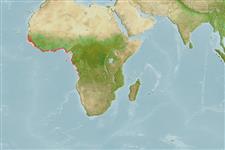Environment: milieu / climate zone / depth range / distribution range
Ecologia
marinhas; Água doce; estuarina demersal; catádromo (Ref. 51243); intervalo de profundidade 0 - 25 m (Ref. 121789). Tropical; 21°N - 20°S, 18°W - 16°E
Length at first maturity / Tamanho / Peso / Idade
Maturity: Lm 17.8 range ? - ? cm
Max length : 41.0 cm FL macho/indeterminado; (Ref. 57400); common length : 27.0 cm SL macho/indeterminado; (Ref. 7399); peso máx. Publicado: 262.00 g (Ref. 55664)
Espinhos anais: 3; Raios anais moles: 10 - 12. Diagnosis: anal fin with at least 13 (usually 14) rays in total (usually III-11 in adults)(Ref. 81659), 10-11 anal soft rays (Ref. 57400). Scales on flanks cycloid; posterior end of maxilla weakly curved or almost straight; serrate, anteroventral edge of lachrymal weakly concave (Ref. 81659). 12-15 scales in an oblique, transverse series; colour of fins greyish-white; second dorsal, pectoral fins and anal fin distinctly falcate (Ref. 57400).
Euryhaline, tolerating conditions varying from hypersaline to freshwater; favours sandy or muddy substrates (Ref. 81659). Very common in coastal lagoons and estuaries (Ref. 2683, 57400, 81659). Also caught in hypersaline environments (Ref. 57400) and freshwaters (Ref. 7399, 57400, 81659) several kilometres upstream in rivers (Ref. 81659). Feed on plankton and detritus (Ref. 28587). Oviparous, eggs are pelagic and non-adhesive (Ref. 205). Spawning may occur in lagoons or in the sea (Ref. 81659). Possibly reaches up to 500mm FL (Ref. 57400, 81659).
Life cycle and mating behavior
Maturities | Reprodução | Spawnings | Egg(s) | Fecundities | Larvas
Thomson, J.M., 1990. Mugilidae. p. 855-859. In J.C. Quero, J.C. Hureau, C. Karrer, A. Post and L. Saldanha (eds.) Check-list of the fishes of the eastern tropical Atlantic (CLOFETA). JNICT, Lisbon; SEI, Paris; and UNESCO, Paris. Vol. 2. (Ref. 7399)
Categoria na Lista Vermelha da IUCN (Ref. 130435)
Ameaça para o homem
Harmless
Utilização humana
Pescarias: espécies comerciais
Ferramentas
Relatórios especiais
Descarregue XML
Fontes da internet
Estimates based on models
Preferred temperature (Ref.
123201): 23.5 - 27.9, mean 26.5 °C (based on 62 cells).
Phylogenetic diversity index (Ref.
82804): PD
50 = 1.0000 [Uniqueness, from 0.5 = low to 2.0 = high].
Bayesian length-weight: a=0.01122 (0.00978 - 0.01287), b=2.94 (2.90 - 2.98), in cm total length, based on LWR estimates for this species (Ref.
93245).
Nível Trófico (Ref.
69278): 2.9 ±0.37 se; based on food items.
Generation time: 2.7 ( na - na) years. Estimated as median ln(3)/K based on 1
growth studies.
Resiliência (Ref.
120179): Médio, tempo mínimo de duplicação da população 1,4 - 4,4 anos (Preliminary K or Fecundity.).
Fishing Vulnerability (Ref.
59153): Low to moderate vulnerability (31 of 100).
Nutrients (Ref.
124155): Calcium = 185 [87, 385] mg/100g; Iron = 1.28 [0.62, 2.58] mg/100g; Protein = 18.4 [16.8, 20.0] %; Omega3 = 0.335 [0.171, 0.717] g/100g; Selenium = 48.6 [25.0, 100.6] μg/100g; VitaminA = 16.5 [5.1, 48.3] μg/100g; Zinc = 1.56 [1.10, 2.25] mg/100g (wet weight);
